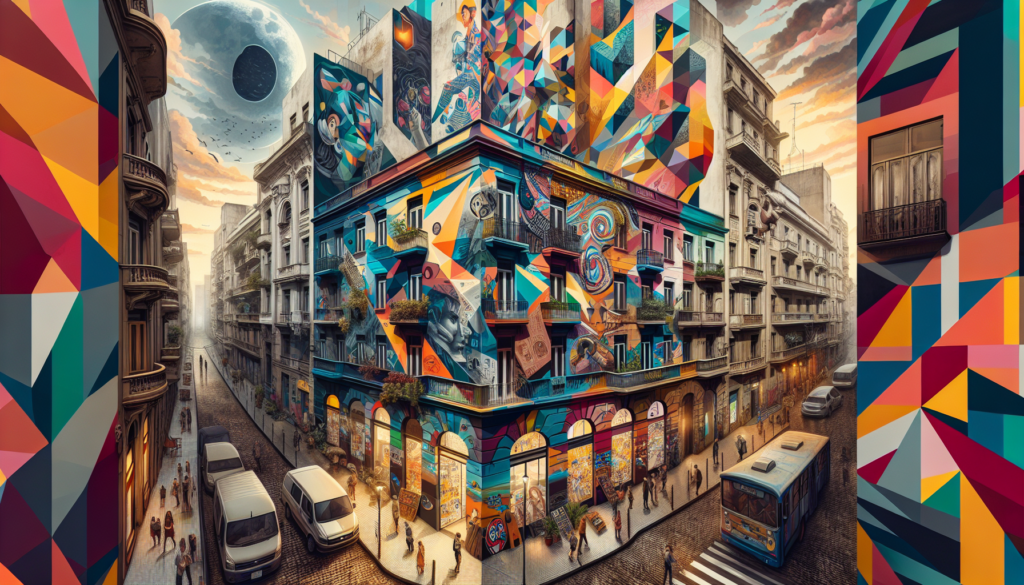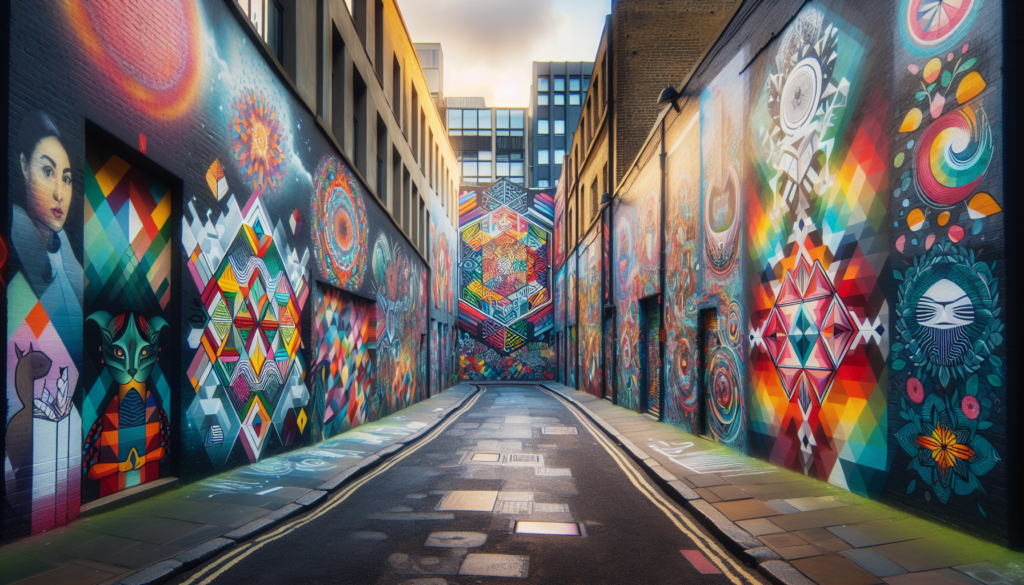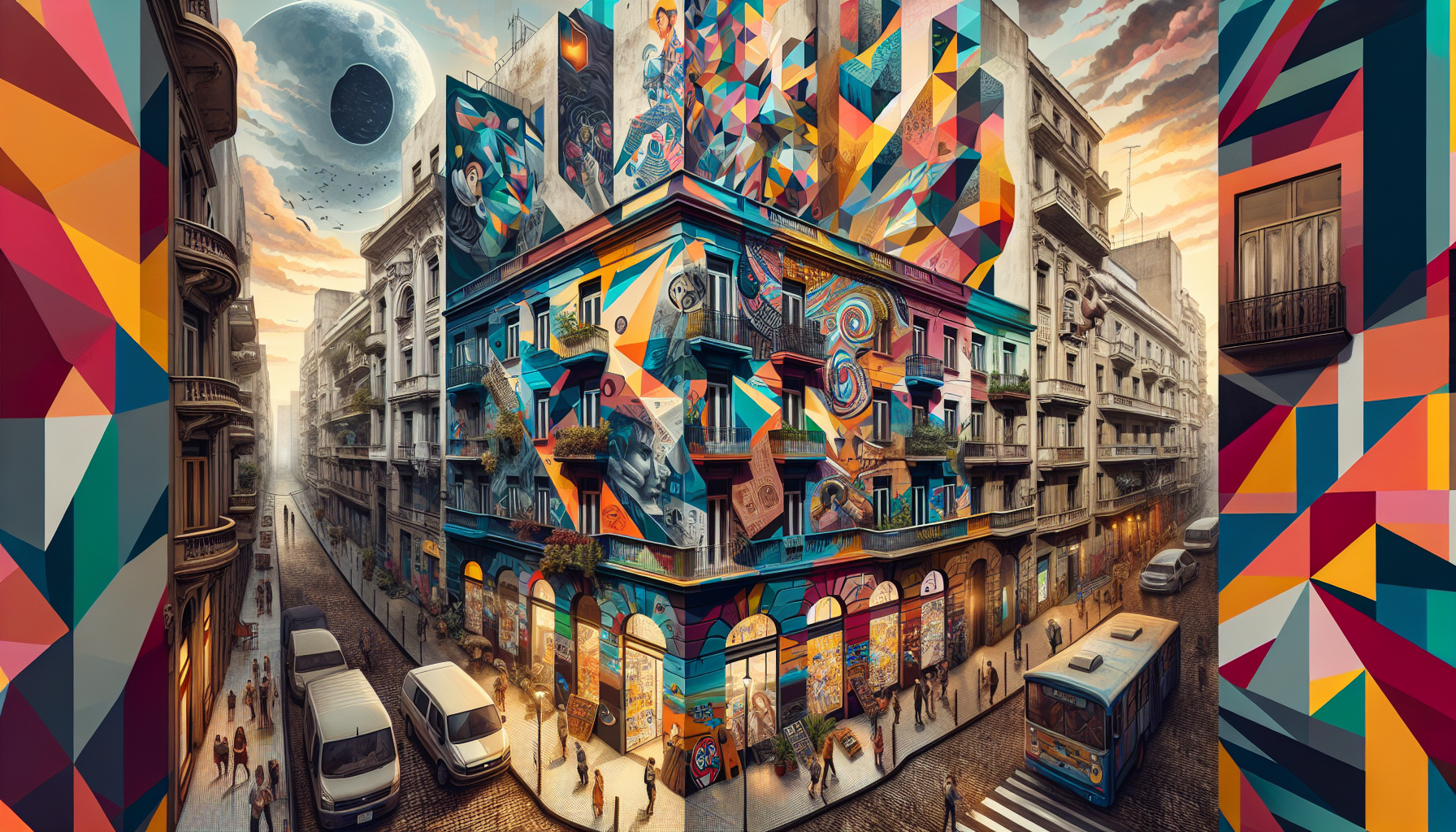Get ready to immerse yourself in the vibrant and captivating world of street art as we take you on a thrilling journey through the colorful streets of Buenos Aires. From the whimsical characters adorning crumbling walls to the thought-provoking murals that tell stories of Argentina’s rich culture and history, this article will invite you to discover the hidden gems of the city’s thriving street art scene.
Join us as we uncover the masterpieces created by talented local artists and delve into the dynamic art culture that has made Buenos Aires a renowned hub for creative expression. So grab your walking shoes and embark on an adventure that will ignite your senses and open your eyes to a whole new world of artistic wonder.

History of Street Art in Buenos Aires
Early Origins of Street Art
The history of street art in Buenos Aires dates back to the early 20th century, when immigrants from Europe brought with them their vibrant artistic traditions. The city began to embrace art as a form of cultural expression, and the streets became a canvas for artists to showcase their talents. What started as simple murals and graffiti soon evolved into a powerful medium for social and political commentary.
Influence of Political and Social Movements
In the 1950s and 1960s, Buenos Aires witnessed a surge in political and social movements, which greatly influenced the street art scene. Artists took to the streets to express their discontent with the prevailing political regime and demand change. The walls of the city became a platform for dissent and a means of voicing the concerns of the people. This era marked a turning point for street art in Buenos Aires, as it began to transcend mere decoration and take on a more profound meaning.
Evolution of Street Art in Buenos Aires
As Buenos Aires continued to undergo social and political transformations, so did its street art scene. Artists began experimenting with different techniques and styles, pushing the boundaries of traditional art forms. What emerged was a diverse array of artistic expressions, ranging from elaborate murals to carefully crafted stencils. Street art became an integral part of the city’s cultural fabric, reflecting the evolving identity and aspirations of its residents.
Famous Street Artists in Buenos Aires
Graffiti Mundo: Promoting Local Talent
Graffiti Mundo is a collective of artists dedicated to promoting and showcasing local talent in Buenos Aires. Through their guided tours, they provide an opportunity for visitors and locals alike to discover the works of the city’s most talented street artists. By sharing the stories and inspirations behind each artwork, Graffiti Mundo sheds light on the rich and vibrant street art culture of Buenos Aires.
Martín Ron: The Giant Murals
Martín Ron is renowned for his larger-than-life murals that adorn the walls of Buenos Aires. His intricate and detailed artworks often depict surreal and fantastical scenes, capturing the imaginations of viewers. Ron’s murals can be found across various neighborhoods in the city, adding a touch of whimsy and wonder to the urban landscape.
Ever Siempre: A Stencil Revolution
Ever Siempre is a pioneer of the stencil art movement in Buenos Aires. His works are characterized by their bold and intricate designs, showcasing his ability to translate complex socio-political themes into visually striking images. Siempre’s stencils can be seen throughout the city, conveying powerful messages of resistance, unity, and social justice.
Jaz: Embracing Argentinian Culture
Jaz is an artist deeply rooted in Argentinian culture and folklore. His artworks often feature traditional symbols and mythical creatures, paying homage to the country’s rich heritage. Through his vibrant and dynamic murals, Jaz seeks to create a sense of identity and connection with the local community.
El Marian: Abstract and Expressive Art
El Marian is known for his abstract and expressive style, which challenges traditional notions of street art. Through his vibrant color palettes and gestural brushstrokes, El Marian creates a visual language that transcends boundaries. His artworks evoke an emotional response from viewers, inviting them to explore their own interpretations and narratives.
Different Styles of Street Art
Graffiti
Graffiti is perhaps the most iconic form of street art, characterized by its bold and colorful lettering. It first emerged in Buenos Aires as a form of self-expression, with artists leaving their mark on the city walls. Graffiti artists utilize a variety of techniques and spray paint to create intricate and visually striking compositions that often convey powerful messages.
Stencils
Stencils have become a popular technique in Buenos Aires street art, allowing artists to create detailed and precise designs. Artists cut out patterns or images from a template and then spray paint over it, leaving behind a crisp and defined image. Stencils provide artists with the ability to reproduce their work quickly and efficiently, making it an ideal method for creating large-scale murals.
Murals
Murals are large-scale artworks that cover entire walls or buildings. They are often highly detailed and encompass a wide range of themes, from social and political commentary to abstract and surreal imagery. Murals serve as a way for artists to interact with the urban landscape while transforming public spaces into vibrant and visually captivating environments.
Paste-Ups
Paste-ups involve the creation of small-scale artworks that are then pasted onto walls or other surfaces. This technique allows artists to work more discreetly and quickly, as the artworks can be easily affixed and removed. Paste-ups often feature a mix of hand-drawn illustrations, photographs, and printed images, resulting in a visually diverse and dynamic street art style.
Interventions
Interventions involve the alteration or modification of existing structures or objects in the urban environment. Artists may add elements, remove parts, or transform the original purpose of an object to create a thought-provoking or visually intriguing piece of art. Interventions challenge traditional notions of art and its relationship with the surrounding environment.
Tile Art
Tile art is a unique form of street art in Buenos Aires, influenced by the city’s rich architectural heritage. Artists use a combination of traditional ceramic tiles and modern techniques to create intricate and colorful mosaics. Tile art often adorns entire facades of buildings, transforming once plain walls into vibrant and visually stunning works of art.
Neighborhoods Full of Street Art
Palermo
Palermo is one of the most eclectic neighborhoods in Buenos Aires, known for its vibrant art scene and trendy atmosphere. It is home to numerous galleries, art studios, and street art hotspots. The streets of Palermo are adorned with colorful murals, stencils, and paste-ups, reflecting the creative energy that flows through the neighborhood. Visitors can explore the hidden alleys and backstreets to discover a myriad of street art gems.
San Telmo
San Telmo is a neighborhood steeped in history and charm, famous for its cobblestone streets and antique markets. It is also a hub for street art, with its walls serving as a canvas for local and international artists. The street art in San Telmo captures the essence of the neighborhood’s bohemian spirit and cultural heritage. Visitors can take a leisurely stroll through the streets, admiring the captivating artworks that adorn the buildings.
La Boca
La Boca is a vibrant and colorful neighborhood that holds a special place in the heart of Buenos Aires. It is best known for its iconic Caminito street, where tango music and vibrant street art combine to create a lively and festive atmosphere. The walls of La Boca are adorned with murals and mosaics that pay homage to the neighborhood’s working-class roots and cultural heritage. Artists from around the world flock to La Boca to leave their mark and be inspired by its unique charm.
Villa Crespo
Villa Crespo is a rapidly evolving neighborhood that has become a haven for artists and creatives. Its streets are a treasure trove of street art, with murals, stencils, and paste-ups adorning the walls. The art in Villa Crespo reflects the neighborhood’s vibrant energy and creative spirit, capturing the essence of its diverse and eclectic community. Walking through the streets of Villa Crespo is like embarking on a visual journey through the evolving world of street art.
Colegiales
Colegiales is a residential neighborhood that has experienced a resurgence in recent years, attracting artists and creative minds. The walls of Colegiales showcase a variety of street art styles, ranging from elaborate murals to small-scale interventions. The neighborhood’s unique blend of traditional and modern architecture provides an ideal backdrop for artists to showcase their work. Exploring Colegiales offers a glimpse into the ever-changing landscape of Buenos Aires street art.

Street Art Tours in Buenos Aires
Graffiti Mundo Tours
Graffiti Mundo offers a range of guided street art tours that provide an immersive experience into Buenos Aires’ vibrant art scene. Led by knowledgeable local guides, these tours take visitors on a journey through the city’s most iconic street art neighborhoods. Participants can learn about the history and cultural context of the artworks while gaining a deeper understanding of the artists behind them.
Street Art BA Tours
Street Art BA Tours offers unique and personalized experiences for those looking to explore Buenos Aires’ street art scene. Their knowledgeable guides take visitors off the beaten path to discover hidden street art gems in lesser-known neighborhoods. The tours provide insights into the creative process, techniques, and stories behind the artworks, allowing participants to engage with the art on a deeper level.
BA Street Art Walk
BA Street Art Walk offers a self-guided walking tour that allows visitors to explore Buenos Aires’ street art at their own pace. The tour covers various neighborhoods and provides a comprehensive map of notable street art locations. Participants can immerse themselves in the vibrant art scene while gaining a deeper appreciation for the city’s rich cultural heritage.
Controversies Surrounding Street Art
Legalization and Regulation
Street art in Buenos Aires exists in a legal gray area. While some artworks are tolerated, others are considered illegal and subject to removal by authorities. The debate surrounding the legalization and regulation of street art continues to spark discussions among artists, property owners, and local authorities. Balancing the preservation of public spaces and artistic expression is a complex challenge that requires ongoing dialogue and collaboration.
Conflict with Property Owners
Street art often raises issues of property rights, as artists may paint on private property without explicit permission. Property owners may have differing opinions on the value and impact of street art, leading to conflicts and debates. Finding a balance between artistic freedom and respecting private property is essential to fostering a harmonious relationship between artists and property owners.
Commercialization and Authenticity
Another controversial aspect of street art is its increasing commercialization. Some argue that the mainstream acceptance and commercial success of street art risk diluting its authenticity and subversive nature. Others believe that commercial opportunities provide artists with sustainable income and wider recognition. Striking a balance between authenticity and commercial viability is a constant challenge for street artists.
Impact of Street Art on the Community
Social and Political Expression
Street art has long been a powerful tool for social and political expression in Buenos Aires. It serves as a platform for marginalized voices and a means of challenging the status quo. The artworks convey messages of resistance, solidarity, and hope, fostering a sense of community and inspiring dialogue on pressing issues. By engaging with street art, residents and visitors alike can actively participate in shaping the social and political narrative of the city.
Tourism and Cultural Identity
Buenos Aires’ vibrant street art scene has become a major draw for tourists from around the world. Visitors flock to the city to experience its rich artistic heritage and immerse themselves in the creative energy that permeates the streets. Street art has also become an integral part of the city’s cultural identity, reflecting the diversity and dynamism of Buenos Aires’ residents. It serves as a symbol of pride and a testament to the city’s enduring artistic spirit.
Revitalization of Neglected Areas
Street art has played a crucial role in revitalizing neglected areas of Buenos Aires. In many neighborhoods, street art has transformed once run-down buildings and abandoned spaces into vibrant art galleries that attract visitors and locals alike. It has breathed new life into forgotten corners of the city, instilling a sense of pride and community ownership. By embracing street art, Buenos Aires has successfully revitalized its urban landscape and brought attention to areas that were once overlooked.
Street Art Festivals and Events
Meeting of Styles
The Meeting of Styles is an annual street art festival that brings together artists from around the world to showcase their talents. Held in different neighborhoods of Buenos Aires, the festival transforms the city into an open-air gallery for several days. Visitors can witness live mural painting, attend workshops, and enjoy cultural performances, immersing themselves in the vibrant atmosphere and artistry of Buenos Aires’ street art scene.
Graffitimundo Week
Graffitimundo Week is a week-long celebration of street art, organized by the Graffiti Mundo collective. The event features guided tours, workshops, and artist talks, providing participants with a deeper understanding of the city’s street art culture. Visitors have the opportunity to engage with local artists, learn about their creative processes, and contribute to collaborative art projects.
Puma Urban Art
Puma Urban Art is a cultural event that brings together street artists, musicians, and performers in a celebration of urban creativity. The event showcases the diversity and talent of Buenos Aires’ street art scene, promoting the city’s cultural heritage to a wider audience. Puma Urban Art provides a platform for artists to engage with the community and create meaningful connections through their art.
International Recognition and Exhibitions
Buenos Aires Biennial
The Buenos Aires Biennial is a prestigious art exhibition that showcases the best of contemporary art, including street art. The biennial features a dedicated street art section, highlighting the work of local and international street artists. The inclusion of street art in such a renowned exhibition demonstrates its growing recognition as a legitimate form of artistic expression.
Urban Art Fair
The Urban Art Fair is a global platform that promotes urban art and provides artists with opportunities for exposure and networking. Buenos Aires has hosted its own edition of the fair, showcasing the city’s vibrant street art scene to an international audience. The fair serves as a bridge between artists, galleries, and collectors, fostering a global appreciation and understanding of street art.
Street Art Exhibitions
Various galleries and cultural institutions in Buenos Aires host street art exhibitions throughout the year. These exhibitions provide a curated space for artists to showcase their work and engage in dialogue with the audience. By exhibiting street art in a gallery setting, these events challenge traditional notions of art and create opportunities for artists to reach new audiences.
Preservation and Conservation Efforts
Government Initiatives
The government of Buenos Aires has taken steps to preserve and protect street art. Recognizing its cultural and touristic value, the city has implemented initiatives to safeguard significant artworks from vandalism or removal. The government works closely with artists and the community to develop guidelines for the preservation and conservation of street art, ensuring its longevity for future generations.
Role of NGOs
Non-governmental organizations (NGOs) play a significant role in the preservation and conservation of street art in Buenos Aires. Organizations such as Graffiti Mundo work closely with artists, property owners, and local authorities to facilitate the creation and preservation of street art. They provide legal and logistical support, ensuring that artists have the necessary permissions and resources to create their works.
Community Engagement
Community engagement is vital to the preservation and conservation of street art in Buenos Aires. Residents and local organizations actively participate in the care and maintenance of artworks, reporting any damage or vandalism to the relevant authorities. Community-led initiatives also contribute to the preservation of street art, fostering a sense of ownership and responsibility among residents.
In conclusion, the history of street art in Buenos Aires is a tale woven with passion, creativity, and a deep sense of social and political consciousness. From its early origins as a form of cultural expression to its current status as a world-renowned art destination, Buenos Aires has embraced street art as a powerful means of communication. The city’s vibrant and diverse street art scene reflects the evolving identity and aspirations of its residents, while also serving as a catalyst for social change and urban revitalization. Through street art, Buenos Aires has carved a unique place for itself in the global art landscape, leaving an indelible mark on the hearts and minds of its visitors.

